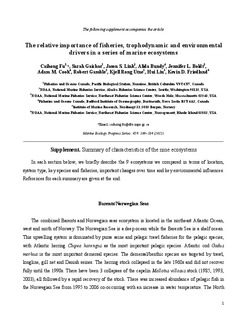| dc.contributor.author | Fu, Caihong | |
| dc.contributor.author | Gaichas, Sarah | |
| dc.contributor.author | Link, Jason S. | |
| dc.contributor.author | Bundy, Alida | |
| dc.contributor.author | Boldt, Jennifer L. | |
| dc.contributor.author | Cook, Adam M. | |
| dc.contributor.author | Gamble, Robert | |
| dc.contributor.author | Utne, Kjell R. | |
| dc.contributor.author | Liu, Hui | |
| dc.contributor.author | Friedland, Kevin | |
| dc.date.accessioned | 2012-11-13T18:29:20Z | |
| dc.date.available | 2012-11-13T18:29:20Z | |
| dc.date.issued | 2012-07-12 | |
| dc.identifier.issn | 0171-8630 | |
| dc.identifier.issn | 1616-1599 | |
| dc.identifier.uri | http://hdl.handle.net/11250/109156 | |
| dc.description.abstract | Marine ecosystems are influenced by drivers that operate and interact over multiple
scales, resulting in nonlinear or abrupt responses to perturbation. Because of the inherent complexity
of marine ecosystems, progress towards an understanding of factors that affect fisheries
production will be most efficient if researchers adopt a comparative approach across ecosystems
using suites of indicators. The goals of this study were to explore a suite of biomass- and catchbased
ecosystem response indicators for 9 northern hemisphere ecosystems relative to indices that
capture the influence of fisheries, trophodynamic and environmental drivers, and to compare the
relative influence of the triad of drivers. Partial least squares regression was used to explore relationships
between the ecosystem response indicators and predictor drivers and to estimate the relative
importance of each of the triad of drivers. Across ecosystems we have identified a few common
observations: (1) environmental drivers, particularly temperature-related independent
variables, are most likely related to total system biomass and biomass of specific biological groups
(e.g. gadoid or clupeid fishes); (2) trophodynamic drivers are most relevant to the mean trophic
level of community and the demersal-to-pelagic biomass ratio; and (3) fisheries drivers tend to be
related to the catch-based indicators, such as fishing-in-balance and percent of primary production
required to support fisheries. Overall, each of the triad of drivers was important for all ecosystems;
however, the relative importance of each driver and the indicators they most affected varied
among ecosystems, suggesting that an examination of a suite of indicators and drivers is
required. A key finding is that fishing is categorically an important driver, but to explain biomass
trends it is very important to consider environmental drivers as well. | no_NO |
| dc.language.iso | eng | no_NO |
| dc.publisher | Inter-Research | no_NO |
| dc.subject | marine ecosystems | no_NO |
| dc.subject | marine økosystemer | no_NO |
| dc.title | Relative importance of fisheries, trophodynamic and environmental drivers in a series of marine ecosystems | no_NO |
| dc.type | Journal article | no_NO |
| dc.type | Peer reviewed | no_NO |
| dc.subject.nsi | VDP::Mathematics and natural science: 400::Zoology and botany: 480::Marine biology: 497 | no_NO |
| dc.subject.nsi | VDP::Mathematics and natural science: 400::Geosciences: 450::Oceanography: 452 | no_NO |
| dc.source.pagenumber | 169-184 | no_NO |
| dc.source.volume | 459 | no_NO |
| dc.source.journal | Marine Ecology Progress Series | no_NO |
| dc.identifier.doi | http://dx.doi.org/10.3354/meps09805 | |
